This article needs additional citations for verification .(January 2021) |
This is a list of amphibians found in Morocco. 12 amphibian species are recorded in Morocco.
This article needs additional citations for verification .(January 2021) |
This is a list of amphibians found in Morocco. 12 amphibian species are recorded in Morocco.
| Common name | Species and authority | Native range | Status (IUCN), population trend | Image |
|---|---|---|---|---|
| Iberian ribbed newt | Pleurodeles waltl (Michahelles, 1830) [1] | Spain, Portugal, and Morocco |  | |
| North African fire salamander | Salamandra algira (Bedriaga, 1883) [2] | Morocco and Algeria |  | |
| Brongersma's toad | Bufo brongersmai (Hoogmoed, 1972) | Endemic of Morocco |  | |
| Common toad | Bufo bufo (Linnaeus, 1758) | In Europe, Kazakhstan, Syria, Morocco, Algeria, and Tunisia |  | |
| Mediterranean tree frog | Hyla meridionalis (Boettger, 1874) | In Spain, Portugal, France, Italy, Monaco, Morocco, Algeria, and Tunisia |  | |
| Pelobates varaldii | Pelobates varaldii (Pasteur & Bons, 1959) | Endemic of Morocco | ||
| Berber toad | Sclerophrys mauritanica (Schlegel, 1841) | In Spain, Morocco, Algeria, and Tunisia |  | |
| Crowned bullfrog | Hoplobatrachus occipitalis (Günther, 1858) | In West Africa, Central Africa, Tanzania, Kenya, Uganda, Ethiopia, Sudan, South Sudan, Libya, Morocco, and Algeria |  | |
| Discoglossus scovazzi | Discoglossus scovazzi (Camerano, 1878) | In Spain and Morocco | 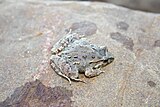 | |
| African green toad | Bufotes boulengeri (Lataste, 1879) | In Spain, Morocco, Algeria, Egypt, Libya, Tunisia, Israel, Jordan, Saudi Arabia, and Italy |  | |
| Sahara frog | Pelophylax saharicus (Boulenger, 1913) | In Egypt and Algeria, Libya, Morocco, Spain, Tunisia, and Spain | 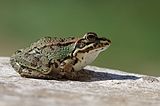 | |
| Alytes maurus | Alytes maurus (Pasteur & Bons, 1962) | In Morocco and Spain |  |

Herpetology is the branch of zoology concerned with the study of amphibians and reptiles. Birds, which are cladistically included within Reptilia, are traditionally excluded here; the scientific study of birds is the subject of ornithology.

Garter snake is a common name for generally harmless, small to medium-sized snakes belonging to the genus Thamnophis in the family Colubridae. Native to North and Central America, species in the genus Thamnophis can be found from the subarctic plains of Canada to Costa Rica.

George Albert Boulenger was a Belgian-British zoologist who described and gave scientific names to over 2,000 new animal species, chiefly fish, reptiles, and amphibians. Boulenger was also an active botanist during the last 30 years of his life, especially in the study of roses.
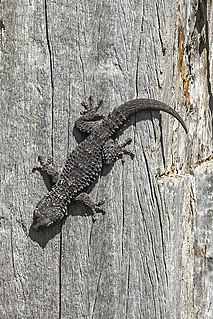
Tarentola mauritanica, known as the common wall gecko, is a species of gecko (Gekkota) native to the western Mediterranean area of North Africa and Europe. It has been introduced to Madeira and Balearic Islands, and the Americas. A nocturnal animal with a predominantly insectivorous diet, it is commonly observed on walls in urban environments in warm coastal areas; it can be found further inland, especially in Spain where it has a tradition of cohabitation with humans as an insect hunter. A robust species, up to 15 centimetres (5.9 in) long, its tubercules are enlarged and give the species a spiny armoured appearance.

Rena humilis, known commonly as the western blind snake, the western slender blind snake, or the western threadsnake, is a species of snake in the family Leptotyphlopidae. The species is endemic to the southwestern United States and northern Mexico. Six subspecies are currently recognized, including the nominate subspecies described here.

A true toad is any member of the family Bufonidae, in the order Anura. This is the only family of anurans in which all members are known as toads, although some may be called frogs. The bufonids now comprise more than 35 genera, Bufo being the best known.
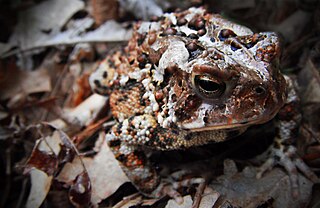
Fowler's toad is a species of toad in the family Bufonidae. The species is native to North America, where it occurs in much of the eastern United States and parts of adjacent Canada. It was previously considered a subspecies of Woodhouse's toad.
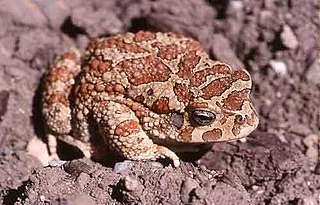
The Berber toad, also known as Mauritanian toad, Moroccan toad, pantherine toad or Moorish toad, is a species of toad in the family Bufonidae, which is found in north-western Africa, with an introduced population in southern Spain.
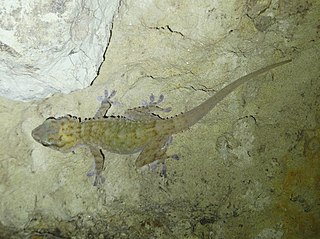
Böhme's gecko, also commonly known as the Morocco wall gecko, is a species of lizard in the family Phyllodactylidae. The species is native to western North Africa, where it is found in rocky areas such as cliffs and walls as well as ruins of buildings and urban areas.

The wildlife of Morocco is composed of its flora and fauna. The country has a wide range of terrains and climate types and a correspondingly large diversity of plants and animals. The coastal areas have a Mediterranean climate and vegetation while inland the Atlas Mountains are forested. Further south, the borders of the Sahara Desert are increasingly arid. Large mammals are not particularly abundant in Morocco, but rodents, bats and other small mammals are more plentiful. Four hundred and ninety species of birds have been recorded here.

The common chameleon or Mediterranean chameleon is a species of chameleon native to the Mediterranean Basin and parts surrounding the Red Sea. It is the only extant species of Chamaleonidae with a range that naturally extends into Europe.
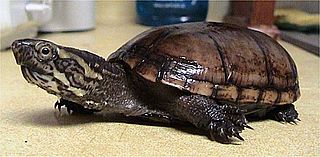
The eastern mud turtle or common mud turtle is a common species of turtle in the family Kinosternidae. The species is endemic to the United States. There are two recognized subspecies.
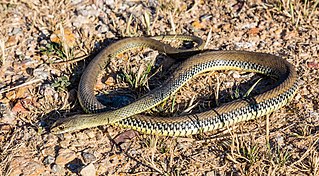
Malpolon monspessulanus, commonly known as the Montpellier snake, is a species of mildly venomous rear-fanged snake.

The four-toed earless skink, also known commonly as Péron's earless skink, the lowlands earless skink, or the four-toed mulch skink, is a viviparous earless skink endemic to southern Australia.
The Reptile Database is a scientific database that collects taxonomic information on all living reptile species. The database focuses on species and has entries for all currently recognized ~13,000 species and their subspecies, although there is usually a lag time of up to a few months before newly described species become available online. The database collects scientific and common names, synonyms, literature references, distribution information, type information, etymology, and other taxonomically relevant information.
iNaturalist is a social network of naturalists, citizen scientists, and biologists built on the concept of mapping and sharing observations of biodiversity across the globe. iNaturalist may be accessed via its website or from its mobile applications. As of June 2022, iNaturalist users had contributed approximately 115 million observations of plants, animals, fungi, and other organisms worldwide, and around 350,000 users were active in the previous 30 days.

The green iguana, also known as the American iguana or the common green iguana, is a large, arboreal, mostly herbivorous species of lizard of the genus Iguana. Usually, this animal is simply called the iguana. The green iguana ranges over a large geographic area; it is native from southern Brazil and Paraguay as far north as Mexico, and has been introduced from South America to Puerto Rico and is very common throughout the island, where it is colloquially known as gallina de palo and considered an invasive species; in the United States, feral populations also exist in South Florida, Hawaii, the U.S. Virgin Islands and the Rio Grande Valley of Texas. Green iguanas have also successfully colonised the island of Anguilla, arriving on the island in 1995 after rafting across the Caribbean from Guadeloupe, where they were introduced.

Robert Cyril Stebbins was an American herpetologist and illustrator known for his field guides and popular books as well as his studies of reptiles and amphibians. His Field Guide to Western Reptiles and Amphibians, first published in 1966, is still considered the definitive reference of its kind, owing to both the quality of the illustrations and the comprehensiveness of the text. A professor of zoology at the University of California, Berkeley, for over 30 years, he was the first curator of herpetology at the Museum of Vertebrate Zoology, a 1949 Guggenheim fellow, and author of over 70 scientific articles. His discovery of the ring species phenomenon in Ensatina salamanders is now a textbook example of speciation, and he performed extensive research on the parietal eye of reptiles. He produced nature films, supported science education in primary grades, and organized conservation efforts that aided in the passing of the 1994 California Desert Protection Act. After retirement he continued to paint, collect field notes, and write books. Stebbins is commemorated in the scientific names of three species: Batrachoseps stebbinsi, the Tehachapi slender salamander; Anniella stebbinsi, a legless lizard; and Ambystoma tigrinum stebbinsi, the endangered Sonora tiger salamander.
Mesalina pasteuri, also known commonly as Pasteur's lizard, is a species of sand-dwelling lizard in the family Lacertidae. The species is endemic to North Africa.